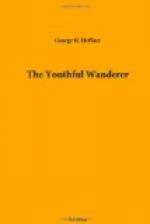The houses in which were born Michael Angelo, Dante, Amerigo Vespucci, Macchiavelli and Galileo may be found and identified by the memorial tablets which mark them.
Piazza della Signoria is the business as well as the historic center of Florence. Here stands the old capitol of the republic, begun in 1298. It was afterwards the residence of Cosmo I. Near this palace is a magnificent fountain of the time of Cosmo I. I cannot tell positively, now, whether the sculpture and architecture of Florence is so much richer than what I saw elsewhere in Europe, or whether the enchanting beauty of sculpturesque and architectural master-strokes at the Cathedral, the Campanile, St. Croce, and the Fountain and Palace in this magnificent square, may not have thrown me into the condition of one in a dream; but I certainly felt all the time that I spent in Florence like one in another world, where scenes of fascinating beauty were surrounding me on every side, and feelings of ecstatic delight precluding me from any but a dream-like enjoyment of the scenery around. I was without any acquaintance or companion the whole day, which in connection with the fact that I was thousands of miles away from the familiar scenes of home, where every object that I contemplated was new and different from what I was wont to see, could not fail to make me feel like one in a dream. I went along the Portico degli Uffizi adorned with throngs of statues of celebrated Tuscans, and into the famous Uffizi Gallery, founded by the Medici, and one of the most precious collections in the world. In the Tribune, the inner sanctuary of the great temple of art ("the richest room in all the world, a heart that draws all hearts to it”) I saw the Venus de Medici, the Dancing Faun, the Apollino, the Wrestlers, and other masterpieces of ancient sculpture; also, among the paintings, some of the best works of Raphael, Angelo, Titian and others. I must however admit that the out-door scenery of Florence charmed me more than what I saw in its world renowned museum. It seems to me, that Raphael and M. Angelo deserve more praise for the inventive genius which they evinced in translating bible stories and poetical imagery into pictures, than for their mechanical execution. To such as understand anything about paintings, it will seem very absurd, of course, that I should presume to criticise the paintings of these great masters, but they must admit that a hundred of those who roam the world and come to see the works of the masters, are ignorant of painting and sculpture, as I am, to half a dozen that are able to criticise them from the standpoint of one who is himself an artist. The “hundred” unskilled in the fine arts, have as great a desire to know how they will likely be affected by the sight of those works as the half dozen artists are; permit me to speak to the “hundred!” It is true that the paintings of Raphael and Angelo may have faded, but, whatever they may have been when they were first hung to the wall, they now look pale, shady and inferior in artistic execution to many of those of Rubens and of the masters of the Dutch school in general; that is, if we consider nature as the standard and copying it as the only criterion of a master’s talents. But for inventive originality of conception, the Dutch masters are no rivals even, certainly not, of the Italians.




